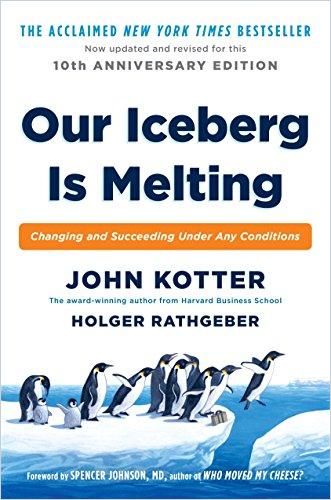Best-selling author John Kotter teams with Holger Rathgeber to present an accessible fable about change initiatives. For many years now, their lovable penguins have been the best change-management teachers around.

A Penguin’s Progress
In this bestseller, now in its 10th anniversary edition, John Kotter and Holger Rathgeber, both organizational performance and change experts, use the model of a fable to teach readers how to institute successful change in today’s tumultuous world.
Kotter is an award-winning author and a professor emeritus of leadership at the Harvard Business School. He co-founded the consulting firm, Kotter International, where former Fortune 500 executive Holger Rathgeber – also Kotter’s co-author for That’s Not How We Do It Here! – is a principal.
While change management can be complex, the authors’ tale makes it accessible and comprehensible, even if the fable format seems a bit strained at times. Kotter and Rathgeber created a rare thing – a charming change-management manual, in this case, featuring delightful penguins. It proves entertaining, practical, applicable and, at times, genuinely witty. Properly followed, their advice can ignite engagement, courage and performance amid corporate change.
Life – which means the past – can be a pretty bad teacher.John Kotter and Holger Rathgeber
Indicating the affection readers have for this fable, the late actress and producer Mary Tyler Moore said, “The penguins in this book will not only steal your heart, they’ll make you a smarter person.” And indicating the breadth of this work’s audience, Heidi King, of the United States Department of Defense, said, “I ordered and distributed 60 copies, evaluated its effect on our change effort, and then ordered 500 more.”
Given the reader loyalty Kotter generates, the best ancillary readings would be his book Leading Change and his and Rathgeber’s That’s Not How We Do It Here!
Stories
Kotter and Rathgeber understand that most people remember stories. The human brain is hard-wired, they explain, to retain information formatted as a narrative.
The book’s story is deceptively simple: A flock of penguins faces a life-threatening habitat problem and addresses it with a change-management strategy. The authors assert that this strategy can work for any organization facing a challenge or dealing with a threat. Regardless of whether Kotter and Rathgeber’s strategy seems right for you, their tale remains a fun read.
Collapse
The authors explain that a colony of emperor penguins had always lived on an Antarctic iceberg. One penguin, Fred, noticed that their iceberg appeared to be melting. As that process continued, the penguin realized, the iceberg would collapse and many penguins would perish.
Culture changes with as much difficulty in penguin colonies as in human colonies.John Kotter and Holger Rathgeber
Kotter and Rathgeber depict Fred’s mission as getting the penguins to do something about the peril they faced. However, Fred remembered that the other penguins had ostracized Harold, a fellow bird who once warned that their iceberg was becoming increasingly brittle.
Leadership Council
The authors depict Fred’s trepidation as he approached the Leadership Council, run by the head penguin, Louis. Fred convinced one member, Alice, to dive into the sea with him and explore the iceberg. As Kotter and Rathgeber relate, Fred showed Alice the flaws in the iceberg and explained their meaning. She invited him to speak to the council.
Showing Fred’s understanding of effective presentations, the authors note that he built a model of the iceberg. Despite Fred’s evidence, a senior penguin, NoNo, said everyone should ignore Fred, especially since he was just a “junior bird.” Kotter and Rathgeber demonstrate Fred’s ingenuity as he proved NoNo wrong.
Louis called for a full assembly and gathered a team to develop and execute a plan.
In these turbulent times, sufficient leadership, not just from the top couple of people, is very important, far too rare, and it does not have to be that way.John Kotter and Holger Rathgeber
The authors offer Louis as the ideal of a wise, respected leader and the leadership group as a well-balanced team. Alice, for one, was down-to-earth and capable. Fred was curious and creative.
Durable Iceberg
Recognizing that most people prefer new circumstances that resemble their old circumstances, Kotter and Rathgeber have the penguins decide to find another iceberg. Louis’s bold words and intrepid demeanor inspired the flock.
The authors caution that practical Alice knew that the planning team had to offer repeated messages about a new home. The penguins created and distributed ice posters saying, “The Nomadic Solution is Logical.”
The authors depict a young teacher who scared little penguins with tales of a difficult move. But the team spoke to her, and she agreed to be supportive.
Penguin scouts found an ideal home, a new iceberg featuring great places to fish and a wall of snow to huddle behind during storms. The penguin colony swam to the new iceberg, and the birds resumed their lives. Now, the authors reveal, they are all bold “change agents” who have learned to welcome new ideas.
Problem-Solving Strategy
The authors caution that you may not be a NoNo, but if you push for change, the NoNos in your organization will try to block you.
More and more people are encountering their own melting icebergs. This creates hazards and opportunities at a rate that knows just one direction: up and up.John Kotter and Holger Rathgeber
Kotter and Rathgeber strongly recommend that your change leaders must inspire urgency, establish a “guiding team,” create a vision and plan for change, explain the plan often, reduce organizational barriers to encourage teamwork, gain small victories, keep the pressure on for change, and cultivate a fresh culture.
The authors caution that you must work to reach a common understanding of what change will entail practically. Kotter and Rathgeber urge you to remain upbeat. The authors assert that you should always present changes as opportunities to improve.
Fables
The advice within this fable is sound, basic and workable. The authors use a light, accessible voice. Fortunately, they don’t try to make the characters overly cute, and they generally avoid schmaltz. However, this business advice book is still a fable, and its effectiveness depends entirely on your receptivity to that form. This is a work for students, brand-new leaders, experienced leaders who have to train people to accept change, or adults working in highly structured environments – such as the military or rigid top-down hierarchical organizations – who prefer less sophisticated breakdowns of business problems and solutions.






